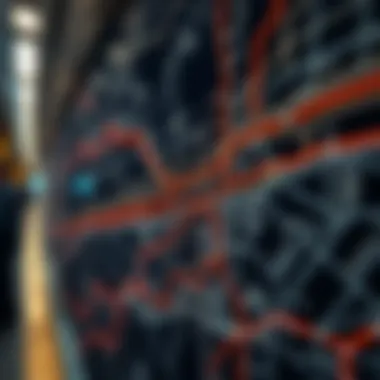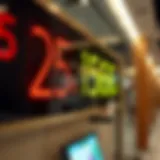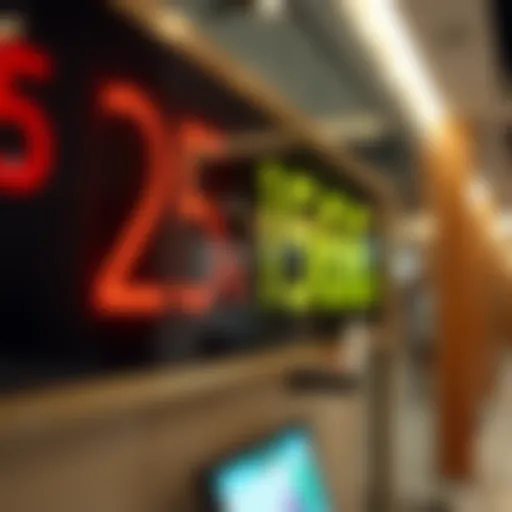Understanding Metro Cost in Dubai: A Complete Overview


Intro
Navigating the intricacies of Dubai's metro system reveals a fascinating world of cost dynamics, fare structures, and ticket options that significantly influence the urban lifestyle. As the city continues to evolve, understanding how these elements interact is crucial for investors, homebuyers, and real estate enthusiasts. This guide aims to shed light on how the metro system impacts commuting patterns, shapes property values, and contributes to economic growth in Dubai.
Market Trends and Insights
Current Market Analysis
As of now, Dubai's metro system stands as a pillar of modern transport, offering efficient connectivity across the city. The fare system is designed to be user-friendly, catering to both residents and visitors. One of the striking features is the Nol card system, which allows users to enjoy seamless travel across all public transport, conveniently integrating with metro services.
Metro fare prices are tiered based on distance, with the average fare hovering around 2 to 8 AED, depending on the zones traveled. This pricing structure aims to make commuting affordable while encouraging the use of public transport, thus alleviating traffic congestion. It has become common to see families, professionals, and tourists alike opting for the metro, which is not only economical but also time-efficient during peak hours.
Historical Trends and Future Predictions
The metro system in Dubai has undergone substantial growth since its inception in 2009. Historical trends indicate a steady increase in ridership, largely due to the rapid urban development and the burgeoning expatriate population.
Looking ahead, several factors are likely to shape the future of metro costs. As infrastructure develops further and new lines are introduced, the efficiency of the system should improve. Economic analysts predict that, alongside rising property values, metro prices may see modest increases. However, the emphasis will likely remain on maintaining accessibility, ensuring that commuters continue to choose the metro over alternative forms of transport.
"The metro system is a lifeline in Dubai, uniquely intertwining daily commutes with real estate trends, making it essential for those seeking to invest in property."
Property Listings and Comparisons
Luxury Properties Overview
In proximity to metro stations, luxury properties are on the rise. Areas like Dubai Marina and Downtown Dubai not only boast stunning views and high-end amenities but also benefit from the convenience of metro accessibility. The real estate market is increasingly reflecting this demand, with developers focusing on creating upscale living spaces just a stone's throw away from transit options. Prices in these regions typically can start around 1.5 million AED and soar higher for penthouses and exclusive units.
Affordable Housing Options
On the other end of the spectrum, there has been a growing trend in affordable housing options near metro lines. The emergence of communities like Dubai Silicon Oasis and Al Qouz offers budget-friendly living spaces, catering to the middle-income demographic. Prices in these areas can range from 500,000 AED to 1 million AED, providing options for those who wish to enjoy the benefits of being connected to the main metro lines without breaking the bank.
Prelude to Dubai's Metro System
Dubai's Metro system stands as a beacon of modern urban transit, reshaping the way residents and visitors navigate this vibrant city. This section unpacks the fundamental components of the metro system, which not only enhances accessibility but also serves as a vital artery connecting various urban hubs. Understanding the particulars of the metro system provides crucial insights for investors and homebuyers keen on integrating their ventures with the city's evolving infrastructure.
Overview of the Metro Network
The Dubai Metro operates a sophisticated network that spans across major districts in the city, facilitating seamless transportation. Stretching over 75 kilometers, it connects pivotal areas like the bustling Dubai Mall, the global business hub of Dubai Marina, and Dubai International Airport, among others.
The system features two main lines: the Red Line and the Green Line. The Red Line, stretching from Rashidiya to UAE Exchange, serves as the backbone of the network, while the Green Line connects the areas of Al Quoz and Creek. Given its extensive reach, the metro is engineered not just to cater to daily commuters but to also support the influx of tourists seeking to explore the city's attractions.
Moreover, the metro is designed with state-of-the-art technology and safety features, making it a reliable choice for urban transport. The introduction of driverless trains is one unique aspect of the system. This not only optimizes efficiency but also minimizes operational costs, aligning with Dubai's broader goals of technological innovation and sustainable growth.
Significance of the Metro in Urban Mobility
The implementation of the metro system has had a profound impact on urban mobility in Dubai. With tens of millions of trips recorded annually, it alleviates pressure on road networks, contributing to a noticeable reduction in traffic congestion. This aspect is increasingly vital as Dubai's population continues to rise, with more people flocking to the city for its myriad opportunities.
An essential benefit of the metro system is its accessibility. It makes commuting easier and affordable for a diverse demographic, from expatriates to tourists, enhancing social inclusivity. The availability of metro stations within proximity to residential areas encourages potential homebuyers to consider properties within walking distance of a station. In terms of economic impact, easier mobility translates to higher productivity levels, as residents can reach workplaces or leisure spots faster and more reliably.
As the metro grows, so does its role in shaping the urban landscape. New developments around metro stations often increase in value, driving interest from real estate investors eager to capitalize on the rising trends in the market.
Understanding the metro system's dynamics is not merely beneficial; it is essential for anyone looking to navigate the opportunities and challenges within Dubai's property landscape.
In summary, the Dubai Metro is more than a transportation solution; it's a catalyst for growth, connectivity, and urban sophistication. Understanding its operations, implications, and the broader context of urban mobility is crucial for engaging with the Dubai real estate market effectively.
Metro Fare Structure
Understanding the fare structure of Dubai's metro system is vital for anyone looking to navigate the city effectively without burning a hole in their pocket. The fare system is not only about reaching one point to another, it defines the mobility patterns of residents and visitors. Travelers can make informed decisions based on their commuting habits, thus contributing to efficient urban mobility. Each type of ticket - from single journeys to monthly passes - offers distinct advantages that cater to different needs and circumstances.


Types of Tickets Available
Single Journey Tickets
Single Journey Tickets stand out as a convenient choice for those who may not travel frequently. They cater to one-time users, enabling them to access the metro without making a long-term commitment. The key characteristic that makes Singles appealing is their flexibility—they can be purchased quickly at various kiosks and vending machines located throughout the station.
- Ease of access: Often chosen by tourists or those on short trips, single journey tickets ensure convenience without the need to invest in a more permanent ticket option.
- Unique feature: This ticket type offers a direct means of payment for day-to-day traveling needs.
However, if someone plans to use the metro multiple times throughout the day, relying solely on single journey tickets may not yield the most economical outcome. The per-trip cost can add up significantly.
Return Tickets
Return Tickets serve as a strategic option for those making a round trip on the same day, like business travelers or others commuting to specific locations. The most notable aspect of return tickets is the cost savings compared to purchasing two separate single journey tickets.
- Cost-Effective: Return tickets can make a round trip less expensive, especially for those needing to get to a meeting and return on the same day.
- Unique feature: These tickets simplify the ticketing process, combining two trips into one straightforward purchase.
Nevertheless, it's worth noting that if someone isn't sure about their return plans, opting for a return ticket can end up being less desirable. Unused tickets might lead to wasted travel funds.
Monthly Passes
For those who commute regularly, Monthly Passes are an unbeatable choice. They streamline travel over the course of an entire month, making them practical for employees or residents relying on public transport daily.
- Unlimited travel: The pass covers all trips within its validity period, making commuting a breeze without the constant hassle of ticket purchases.
- Unique feature: These passes may also offer additional perks, such as discounts, that are unavailable for other ticket types.
On the flip side, anyone using a metro infrequently may find Monthly Passes less favorable, as the initial investment may not be justified. It’s crucial for users to assess their commuting patterns before investing in a monthly pass.
Fare Calculation
Distance-Based Pricing
The distance-based pricing model is central to understanding metro fares in Dubai. This approach ensures that travelers only pay for the distance they travel, an equitable solution that resonates with local commuters.
- Fair and transparent: By charging based on distance, commuters can control their costs more effectively.
- Unique feature: The clear mapping of fare zones allows users to anticipate costs ahead of time.
However, it's essential for users to be aware of the fact that longer journeys can escalate fares quickly, potentially leading to unexpected expenses.
Zones Explained
An integral part of fare calculation comes down to understanding how zones work. The metro network has been divided into several zones, and the fares adjust according to how many zones a passenger traverses.
- Efficient system: This organized structure simplifies the pricing process, allowing passengers to understand costs easily based on their starting and ending points.
- Unique feature: The predetermined zones facilitate planning ahead for travel expenses, particularly beneficial during busy office commute hours.
Nonetheless, travelers might occasionally find themselves confused when switching zones, leading to possible fare miscalculations.
Discounts and Promotions
Discounts for Students
Student discounts provide much-needed savings for young commuters navigating city life while managing tight budgets. These discounts demonstrate an understanding of their financial constraints, encouraging transportation options for students.
- Financial relief: Significant reductions on fares make commuting more affordable for students, fostering a culture of public transport use among youth.
- Unique feature: Carrying a valid student ID grants access to reduced fares at various times throughout the day.
However, eligibility can vary by institution or age, so students should keep up to date with the latest requirements for discount validity.
Seniors and Disabled Discounts
Seniors and individuals with disabilities are provided discounts to promote inclusivity and ensure everyone can access the metro system. These discounts highlight the city's commitment to making public transport available for all demographics.
- Accessibility: This initiative encourages more senior citizens to utilize the metro, promoting independence in their mobility.
- Unique feature: These discounted options can significantly lower travel costs, allowing these groups to travel comfortably.


Yet, there might be instances when not all stations are fully equipped to cater to accessibility needs, which could be a downside for certain users.
In summary, a comprehensive understanding of the metro fare structure not only enhances the commuting experience but also opens doors to significant financial savings. Knowledge about ticket types, fare calculation, and available discounts can lead to more informed and efficient travel decisions.
Factors Influencing Metro Costs
Understanding the costs associated with Dubai's metro system is not just an exercise in numbers; it's a window into the larger economic framework of urban transport. Multiple elements play a role in determining these costs, and grasping them offers insights that can impact decisions for investors, real estate professionals, and everyday commuters. Factors like operational expenses, government policies, and technological developments intricately weave together to form a complex tapestry that affects fare pricing and overall sustainability of the metro system.
Operational Expenses
Operational expenses essentially shape the financial landscape of metro services. This category includes direct costs like manpower, maintenance, and energy consumption, to name a few. If you think about it, keeping trains running smoothly, maintaining cleanliness in stations, and ensuring safety protocols are never-ending tasks that incur significant expenditures.
For instance, consider the cost of electricity used to power the trains. These expenses can fluctuate based on market prices, affecting ticket fares directly. In addition to that, employee wages—whether for drivers or maintenance staff—make up a notable portion of the expense pie. Operating a metro system is comparable to running a small city—it needs a constant flow of resources to keep everything ticking.
Government Policies
Government backing is also pivotal in shaping metro costs. Policies that provide for subsidies, tax exemptions, or direct funding influence pricing structures profoundly. If the government opts to lower fares through subsidies, it may ease the burden on commuters but could strain the financial viability of the metro system in the long run.
Furthermore, regulations surrounding public transport can dictate standards that must be met. Enhancing passenger facilities, improving accessibility, or introducing environmentally friendly options might come with significant initial costs, but these investments can lead to a more robust system over time. Ultimately, government decisions have a cascading effect on mobility economics and the cost of fares in Dubai.
"The delicate balance between affordability and sustainability lies at the heart of Dubai's metro financial strategy."
Technological Advancements
As the adage goes, "technology is a double-edged sword." It's vital to recognize that while advancements can lead to efficiencies that reduce operational costs, they often demand hefty investments upfront. Innovations like automated ticketing systems, smart train management, and real-time tracking applications bring both value and expense.
Take, for example, the shift to energy-efficient trains. While the initial outlay may raise costs, it tends to lead to savings in the long run through reduced energy use and maintenance needs. Essentially, these technological strides are not just about keeping pace—they're about future-proofing the metro system, ensuring that it can withstand increasing demands without exorbitant fare hikes.
In summary, factors influencing metro costs in Dubai represent a blend of direct expenses, policies instituted by the government, and the impact of technological developments. For stakeholders—whether they be investors eyeing real estate opportunities or commuters budgeting for their daily journeys—understanding these layers will be invaluable in making informed decisions in a city where mobility is key.
Impact of Metro on Real Estate Values
The influence of Dubai's metro system extends far beyond the mere convenience of travel; it significantly sways real estate values across the city. It’s essential to understand how proximity to metro stations, overall neighborhood development, and market comparisons play pivotal roles in this segment of urban economics.
Proximity to Metro Stations
Finding a home close to a metro station often means finding a better property value. This is not just a fleeting trend but a solid truth that buyers and investors recognize. Properties situated within a comfortable distance from metro stations usually enjoy higher demand. A concise look at this phenomenon shows that accessibility is a key driver in property pricing.
Living near metro stations can enhance a property’s appeal. Investors looking for rental income know that tenants appreciate the convenience of quick connections to work and leisure spots. The influence of this proximity is reflected in rental rates, where apartments just a few minutes' walk from station entrances tend to command a price premium, sometimes by as much as 15-20%. Additionally, first-time buyers, particularly young professionals or families, are keen on accessible locations, further inflating demand.
Neighborhood Development
Development around metro stations is not merely incidental. The Dubai metro system catalyzes a transformation of neighborhoods into vibrant urban hubs. Consequently, this can lead to an increase in local amenities, including parks, shops, and dining establishments. Such enhancements lead to a more attractive living environment, significantly boosting real estate values.
Investment in infrastructure attracts businesses, schools, and services, making the area more desirable. For instance, neighborhoods that experience metro station upgrades often see new commercial developments springing up, bringing life to previously underdeveloped areas. This can create a domino effect, where the rise in property values encourages further investment, resulting in a continuous cycle of appreciation.
Market Comparisons
When comparing areas within Dubai that are accessible to the metro versus those that aren’t, the differences in real estate values become evident. Areas serviced by metro lines often outpace their counterparts that rely solely on bus routes or car travel. This could lead to a situation where two neighborhoods—one with metro access and one without—exhibit a disparity in property values, sometimes exceeding 30%.
Even within the same company, properties near metro stations can fetch higher prices on resale. This information is vital for investors to understand market trajectories, as proximity to the metro has shown to be a reliable indicator of future growth potential.
"Accessibility, represented by the proximity of metro stations, isn't just a preferable convenience; it's an essential aspect of property valuation in Dubai's thriving real estate market."
In essence, understanding the interconnected relationship between the metro and real estate can aid in making informed investment decisions. As the city continues to expand and evolve, the metro's influence will undoubtedly play a key role in shaping market dynamics.
User Experiences and Testimonials


Understanding how people perceive and interact with the metro system in Dubai is crucial to appreciating its role in the city’s transit landscape. User experiences not only shed light on the actual utility of the metro but also offer insights into its impact on daily commuting. Testimonials and feedback provide a human angle that data alone cannot convey. They help to pinpoint the strengths and weaknesses of the metro service, making it clearer for potential investors and users what they can expect.
Commuter Feedback
Personal accounts from commuters reflect their tangible experiences, highlighting what works well and what leaves room for improvement. For instance, many commuters praise the punctuality of the metro trains. One frequent user shared that, "I rarely have to wait more than five minutes for a train, which is a game-changer when you’re juggling a busy schedule."
Moreover, convenience is a recurring theme. Commuters like Sarah, a working mom, have expressed comfort in knowing they can avoid the gridlock typical of Dubai’s roads, saying:
"Taking the metro has saved me hours each week. The trains are clean, and it feels safe, unlike driving with the kids in rush hour."
However, not all feedback is glowing. Some users have pointed out the occasional overcrowding during peak hours, leading to frustrations. A commuter noted, "It’s great when it’s not packed, but sometimes it feels like a can of sardines during the morning rush."
This nuanced feedback is invaluable for understanding and illustrating the metro's real-time effectiveness and user satisfaction. Investors and developers can utilize these insights to gauge areas needing enhancements and how the service can better cater to its ridership.
Comparative Analysis of Other Transport Modes
Examining the metro system through the lens of other transportation methods is key to showcasing itsadvantages. The metro serves as a backbone for public transportation in Dubai, often positioned against bus services and private vehicles.
- Cost Efficiency: Compared to taxis, the metro is often more cost-effective. A taxi ride from Downtown Dubai to Dubai Marina can run you upwards of AED 60, while a metro fare for the same journey may only be around AED 8.
- Time-Saving: Metro users frequently mention that the train to Dubai Marina gets them there in under 30 minutes, while taking a car can easily take 60 minutes or more during rush hour. This advantage makes the metro an attractive option for time-conscious commuters.
- Environmental Impact: The metro system is also seen as a more sustainable mode of transport. Unlike cars that contribute to pollution, trains run on electricity, offering a greener alternative. As noted by one commuter, "I feel better knowing I'm contributing a bit to reducing traffic and pollution by opting for the metro."
It's clear that while taxis and buses have their place, the metro stands out for its reliability and efficiency. This comparative analysis serves as a valuable resource for potential investors and stakeholders looking to understand the metro’s role in Dubai's overarching transport strategy.
User experiences and their comparative insights help paint a fuller picture of the metro's significance within the city's transport fabric, echoing its value for residents and visitors alike.
Future Developments in the Metro Network
The future of Dubai's metro system is not just about moving people from point A to point B; it’s aimed at enhancing the overall urban experience. As cities evolve, so must their transportation networks. Future developments in the metro network play a crucial role in not only streamlining the flow of traffic but also in shaping the economic landscape of Dubai. Understanding these developments offers insight into the city’s ambition to maintain its status as a global hub for business and tourism.
Expansion Plans
Expansion plans are at the forefront of the metro’s future in Dubai. The city's leadership has recognized the importance of comprehensive public transit to accommodate a growing population and tourism influx. Current proposals include:
- New Metro Lines: Additional lines are expected to stretch into new neighborhoods, linking previously underserved areas to the existing network. This can particularly benefit real estate developers and homebuyers, who may see a rise in property values as accessibility improves.
- Increased Capacity: Enhancements will focus on increasing the capacity of existing lines, thereby reducing overcrowding and wait times during peak hours. This will provide a more comfortable commuting experience.
- Integration with Other Transport Modes: Plans to seamlessly connect the metro with other transport options like buses, trams, and even water taxis are on the table. This holistic approach creates a multi-modal transport environment that benefits commuters and investors alike.
By incorporating these expansions, Dubai’s metro is setting the stage to better serve its residents while also ensuring that investor interests are met through enhanced infrastructure.
Innovations in Metro Services
The future isn’t just about expansion; it’s also about making the ride smarter and more efficient. Innovations in metro services are set to transform the commuting experience in Dubai:
- Smart Ticketing Solutions: The introduction of digital ticketing and payment systems is expected to simplify fare collection. This will enable commuters to use mobile applications for real-time information, reducing the need for physical ticket kiosks.
- Real-Time Tracking: With the integration of AI and IoT solutions, riders can expect real-time updates on train arrivals and delays, ensuring they can plan their journeys more effectively.
- Sustainability Initiatives: The metro is also looking into greener technologies, including energy-efficient trains and solar power utilization at stations. This not only aligns with global sustainability goals but also opens doors for investors focused on green initiatives.
The future developments in Dubai’s metro network signify a promoting factor not just for urban mobility, but also a promising avenue for economic growth and real estate value augmentation.
Investors and homebuyers should keep a keen eye on these advancements, as they will undoubtedly shape the fabric of future urban living in Dubai. For comprehensive updates, consider checking resources like Dubai's Roads and Transport Authority or relevant articles on Wikipedia that delve into ongoing transformation.
The End
Understanding the metro cost in Dubai isn't just a topic of transport; it extends into various layers that affect daily life, economic growth, and real estate dynamics. In this article, we dissected the fare structure, explored ticket options, and assessed the factors influencing prices. The significance of this topic is multifaceted, impacting not only how individuals commute but also how residents perceive property values and urban development potentially flourishes.
Recap of Key Insights
To sum up, the metro system is more than just a network of trains. It serves as a backbone for urban mobility in a city that thrives on its rapid growth and innovation. Key takeaways include:
- Fare Structure: Various ticket types suit the needs of commuters, from single journey to monthly passes. This flexibility allows both residents and visitors to navigate the city efficiently.
- Economic Influences: The operational expenses, coupled with government policy decisions, play a crucial role in shaping metro fare costs. As such, understanding these dynamics is essential for investors and commuters alike.
- Impact on Real Estate: Proximity to metro stations often correlates with higher property values. This connection shows a tangible impact of transport infrastructure on residential choices and development trends.
Final Thoughts on Metro's Role in Dubai
As Dubai continues to expand and modernize, the metro system will undoubtedly remain a vital component of its urban framework. This infrastructure not only facilitates day-to-day commuting but also signals a commitment to sustainable transport solutions. As the city invests in further developments and technological innovations, we can anticipate the metro's role will only grow stronger.
Given the ever-changing landscape of urban living and economic activity, understanding the implications of metro costs is crucial for anyone involved in the property market. It not only equips investors and homebuyers with valuable insights but also fosters a broader conversation about urban planning and community development.
"A city is not just a place, it's a living entity, evolving and adapting to the needs of its inhabitants. In Dubai, the metro is a key part of that evolution."
For further insights, check related topics on Dubai Economy or join discussions on Reddit.















